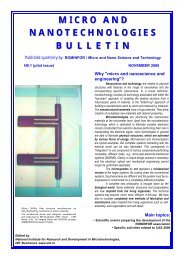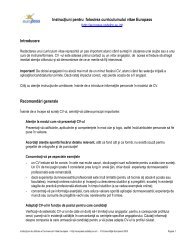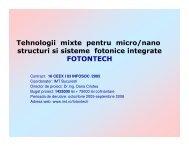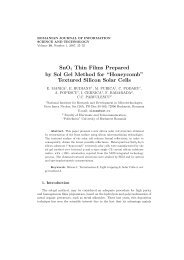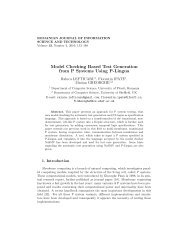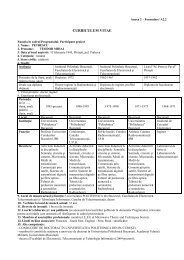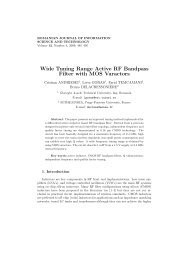C. Iliescu - IMT
C. Iliescu - IMT
C. Iliescu - IMT
- No tags were found...
You also want an ePaper? Increase the reach of your titles
YUMPU automatically turns print PDFs into web optimized ePapers that Google loves.
Dielectrophoresisfrom 2D to 3D, from micro to nano….Ciprian <strong>Iliescu</strong>
Working with platform technologies !Standard microfabricationprocessesWet etchingthroughPyrex glassPhotolithographyonnonplanar surfaceAdhesive wafer-to-waferbonding
Dielectrophoresis from 2D to 3D- outline -1. Introduction:a. Dielectrophoresis?b. DEP forcec. Polarization factord. Positive and negative DEPe. Classification of the DEP devicesf. Problems associated with DEP2. Structures of DEP with 3D electrodes and asymmetric electrodes3. Simulation of the electric field in DEP structures4. Consideration about Joule effect5. Consideration about fabrication process6. Application 1: cell trapping7. Application 2: cell sorting8. DEP for nanoparticles9. DEP filter10.DEP chip for liver cells assembly and culture
Dielectrophoresis ?Motivations…Definition:ApplicationsParticle trappingParticle separationDielectrophoresis (DEP) = the movement of the neutral (but polarisable)particles in an electric field that is spatially inhomogeneous.Micro-sizeNano-size
DEP ForceThe DEP force acting on a spherical particle:F3= 2πrε Re[ K ]mPolarization factor (!):∇E2K=(* *) (* *ε −εε + 2ε)pm/p mComplex permittivity( σ ω)*ε = ε − j /
Re [K] versus frequencyfor viable yeast cellsPolarization factorPositive DEPNegative DEPYang, J., Y. Huang, X. Wang, X-B, Wang, F.F. Beckerand P. R. C. Gascoyne. 1999. Biophysical J. 76: 3307-3314.L. Yu, C. <strong>Iliescu</strong>, G. Xu and F.E.H. Tay,JMEMS, vol. 16, issue 5, October 2007, pp1120-1129.
Positive and negative DEPPositive DEPNegative DEP
Classification of DEP devicesKey point: generation of a gradient of the electric fieldElectrode’s shapePhase changingModification ofdielectric media3D-iDEP filter3D electrodesAsymmetricelectrodesC. <strong>Iliescu</strong>, G.L. Xu, F.C. Loe, P.L. Ong and F.E.H. Tay,“A 3 dimensional dielectrophoretic filter chip”,Electrophoresis, vol. 28, issue 7, 2007, pp. 1107-1114C. <strong>Iliescu</strong>, L.M. Yu, G.L. Xu and F.E.H. Tay, JMEMS,vol. 15, no. 6, 2006, pp. 1506-1513,C. <strong>Iliescu</strong>, G.L. Xu, V. Samper and F.E.H. Tay, Journal ofMicromechanics and Microengineering, vol. 15, no. 3,2005,494-500
Problems related DEP1. Joule effect in DEP device (especially forapplication on biological samples !)2. Possible modification induce by the electric fieldon biological samples
1. Introduction2. Structures of DEP with 3D electrodes and asymmetric electrodesa. DEP with 3D electrodesb. DEP with asymmetric electrodes (3D electric field gradient)3. Simulation of the electric field in DEP structures4. Consideration about Joule effect5. Consideration about fabrication process6. Application 1: cell trapping7. Application 2: cell sorting8. DEP for nanoparticles9. DEP filter10.DEP chip for liver cells assembly and culture
Structure of DEP chip – 3D electrodes
Structure of DEP chip - asymmetric electrodes
1. Introduction2. Structures of DEP with 3D electrodes and asymmetricelectrodes3. Simulation of the electric field in DEP structures4. Consideration about Joule effect5. Fabrication process6. Application 1: cell trapping7. Application 2: cell sorting8. DEP for nanoparticles9. DEP filter10.DEP chip for liver cells assembly and culture
Electric field gradient & DEP forceCo-workers: L. Yu, G.L Xu
Electric field gradient & DEP forcePlanar electrodes 3D electrodes Asymmetric electrodesΔT≈σVk2Increase the voltage !Need more force?Increase the voltage !Increase thetemperature!
1. Introduction2. Structures of DEP with 3D electrodes and asymmetric electrodes3. Simulation of the electric field in DEP structures4. Consideration about Joule effect in DEP devices5. Fabrication process6. Application 1: cell trapping7. Application 2: cell sorting8. DEP for nanoparticles9. DEP filter10.DEP chip for liver cells assembly and culture
Joule effectCo-workers: A.J. PangPlanar electrodes 3D electrodes Asymmetric electrodesT=134 C T=40 C T=86 CΔTσV≈k2ΔTσV≈8k2The structure is suitablefor trapping nanoparticles(or even viruses) !
Joule effectThe relationship between change intemperature and applied voltageThe relationship between change intemperature and electric conductivity ofmediumF.E.H. Tay, L. Yu, A.J. Pang and C. <strong>Iliescu</strong>, “Electrical and thermal characterization of a dielectrophoretic chip with 3Delectrodes for cells manipulation,” Electrochimica Acta, vol. 52, issue 8, 2007, 2862-2868
1. Introduction2. Structures of DEP with 3D electrodes and asymmetricelectrodes3. Simulation of the electric field in DEP structures4. Consideration about Joule effect5. Fabrication process (DEP with asymmetric electrodes)6. Application 1: cell trapping7. Application 2: cell sorting8. DEP for nanoparticles9. DEP filter10.DEP chip for liver cells assembly and culture
Fabrication processAnodic bonding of 100 um silicon wafer on glass- Glass wafer- Corning 7740 with drilled holes- Silicon wafer- heavy doped, 100um-thick- Bonding conditions: T=305 C, F=500N, U=1000V (I reached 40% from the initial value)DRIE of silicon wafer (thick electrode+ microfluidic channel)-PECVD SiO2 mask (1um-thick)-Alignment from the back side using ring feature-Etching in a ICP DRIE/ Bosch process (SF6/C4F8) – afterbonding with wax on a dummy Si wafer
Fabrication processFabrication of the thin electrode (doped a:Si on glass)-Main disadvantage of a:Si – high compressive stress (500-600 MPa)- a:Si - difficult to be doped- Solution : annealing* doping with Al (solid source), followed by annealing at500C/3h in vacuum. Resistivity 100ohm/sq, stress 150MPa compressive.a) PR mask over a sandwich structurea:Si(2.5um)+Al(0.5um)b) Al etch (RIE etch using SiCl4)c) a:Si etch (Bosch process)d) PR removing and annealing* C. <strong>Iliescu</strong>, J. Miao and F.E.H. Tay, “Optimization of PECVDamorphous silicon process for deep wet etching of Pyrex glass,”Surface and Coatings Technology, vol. 192/1, 2005, 43-47
Fabrication processAnodic bonding +aligning of the wafers- Bonding conditions: T= 450 C, U=1500V, F=1000NThinning of the bottom wafer to 100 um (wet etching process)-A thinning process up to 100um is required-Wet etching process in an optimized HF/HCl (10/1)**-The roughness of the generated surface was 10nm** C. <strong>Iliescu</strong>, J. Jing, F.E.H. Tay, J. Miao and T.T. Sun, “Characterization of masking layers for deepwet etching of glass in an improved HF/HCl solution,” Surface and Coatings Technology, vol. 198/1-3, 2005, 314-318
**** L. Yu, Y.Y. Lee, F.E.H. Tay, C. <strong>Iliescu</strong>, “Spray coating of photoresist for 3D microstructures with different geometries,” J. Phys.: Conf. Ser., vol. 34,2006, 937-942Via –holes fabricationFabrication process-The initial diameter of via-holes was 50um-Wet etch process in the same HF/HCl solution using Cr/Au mask (optimized in ***)-Process with “etch-stop” on a:Si membraneMetallization- Cr/Au & Al deposition were used for metallization- Critical aspect patterning of the metal layer ****)*** C. <strong>Iliescu</strong>, F.E.H. Tay and J. Miao, “Strategies in deep wet etching of Pyrex glass,” Sensors and Actuators A, vol. 133/2, 2007, 395-400
Fabrication processPhoto of the fabricated DEP with 3D electricfield gradient (asymmetric electrodes)
1. Introduction2. Structures of DEP with 3D electrodes and asymmetricelectrodes3. Simulation of the electric field in DEP structures4. Consideration about Joule effect5. Fabrication process6. Application 1: cell trapping7. Application 2: cell sorting8. DEP for nanoparticles9. DEP filter10.DEP chip for liver cells assembly and culture
Cells trapping (positive DEP)Planar electrodes 3D electrodes Asymmetric electrodes
Cells trapping (negative DEP)Asymmetric electrodesFnDEPFor nDEP the cells arelevitated at 30-35um !
1. Introduction2. Structures of DEP with 3D electrodes and asymmetric electrodes3. Simulation of the electric field in DEP structures4. Consideration about Joule effect5. Fabrication process6. Application 1: cells trapping7. Application 2: cells sortinga. Sequential cells sorting in DEP with 3D electrodesb. Separation under the continuous flowc. Bidirectional separator8. DEP for nanoparticles9. DEP filter10.DEP chip for liver cells assembly and culture
Cells separation –DEP with 3D electrodesSequential flow separation in aDEP device with 3D electrodesElectric fieldFlow gradientSeparation principleL. Yu, C. <strong>Iliescu</strong>, G. Xu and F.E.H. Tay, JMEMS, vol. 16, issue 5, October 2007, pp 1120-1129.
Cells separation–DEPwith 3D electrodesViable and non-viable yeast cellseparation using sequentialfield-flow separation method ina DEP chip with 3D siliconelectrodeOptical view with the DEP devicewith lateral inlet/outlet
Cells separation –DEP with 3D electrodesContinue flow separation in a DEP device with 3D electrodesSeparation principleC. <strong>Iliescu</strong>, G. Tresset and G.L. Xu, Applied Physics Letters,vol. 90, issue 23, June 2007, pp. 234104/1-3Optical view taken duringthe separation process
Bidirectional separationSchematic view of the DEP deviceSeparation principle
Testing of the bidirectional DEPseparatorBidirectional separationPhoto with theDEP deviceC. <strong>Iliescu</strong>, L.M. Yu, F.E.H. Tay and B.T. Chen, Sensors andActuators B, vol. 129, issue 1, January 2008, pp. 491-496(presented at “Transducers an Eurosensors” July 2007)
1. Introduction2. Structures of DEP with 3D electrodes and asymmetric electrodes3. Simulation of the electric field in DEP structures4. Consideration about Joule effect5. Fabrication process6. Application 1: cells trapping7. Application 2: cells sorting8. DEP for nanoparticles (in testing)9. DEP filter10.DEP chip for liver cells assembly and culture
DEP chip for nanoparticles trapping• Motivation: viruses purification• Challenges:DEP force acting on a spherical particle:•F3= 2πrε Re[ K]m∇E2F ~ volume of the particle !Joule effect
DEP chip for nanoparticles trapping• Schematic view:••
DEP chip for nanoparticles trapping• Fabrication process:•a) SOI silicon waferb) Etching of Si electrodesc) Ti/Pt electrodes on glassd) Etch through holes for inlet/outlet and electricalcontacte) Anodic bonding Si/glass
DEP chip for nanoparticles trappingSEM and optical images with the fabricated electrodesFabricated DEP chips
1. Introduction2. Structures of DEP with 3D electrodes and asymmetric electrodes3. Simulation of the electric field in DEP structures4. Consideration about Joule effect5. Fabrication process6. Application 1: cells trapping7. Application 2: cells sorting8. DEP for nanoparticles9. DEP filtera. Structureb. Simulationsc. Fabricationd. Resultse. Cells sorting in 3D iDEP filter10.DEP chip for liver cells assembly and culture
3D iDEP chip – cells trappingCo-workers: Felicia Loe (GPBE_NUS)Poh Lam OngPhotos with the DEP filtering chipSchematic view of the DEP filtering chip
Simulation of the electric field and flowElectric field simulationusing Maxwell softwareSimulation of the flowvelocity between thebeads using ANSYS
Fabrication processa) Cr/Au deposition on both sides of a1mm glass waferb) Cr/Au patterned with 1st mask andetched in clasical Cr/Au echants.c) Central hole created via simultaneousetching of glass wafer from both sides inconc.HF (49%).d) Cr/Au layer patterned with 2nd mask tocreate a bonding ring.f) Wire mesh solder bump to Cr/Au bondingring on one side of wafer.g) Silica beads packed into central hole.h) Wire mesh is solder bump to Cr/Au ringon other side of wafer. Enclosing thesilica beads.
Testing setupCell suspension pumped inFunnel adaptorDeviceCollectioncontainer
ResultsInfluence of the applied voltage and theflowing rate on capture efficiencyThe device was tested also in DC !C. <strong>Iliescu</strong>, G.L. Xu, F.C. Loe, P.L. Ong and F.E.H. Tay, Electrophoresis, vol. 28, issue 7, April2007, pp. 1107-1114
3D iDEP Chip – Cells separationWorking principle of cells separationin a 3D iDEP chipC. <strong>Iliescu</strong>, G.L. Xu, P.L. Ong and K.J. Leck, Journal of Micromechanics and Microengineering, vol. 17/ 7, 2007,S128-S136.
1. Introduction2. Structures of DEP with 3D electrodes and asymmetricelectrodes3. Simulation of the electric field in DEP structures4. Consideration about Joule effect5. Fabrication process (DEP with asymmetric electrodes)6. Application 1: cell trapping7. Application 2: cell sorting8. DEP for nanoparticles9. DEP filter10. DEP chip for liver cells assembly and culture (in testing)
Tissue reconstruction: state-of-the-artTissue Reconstruction Based on Cell Sheet Engineering, Teruo OkanoNature 421, 884-886 (2003)Nature Medicine 13, 880-885 (2007)Courtesy of J. Hsieh- IBN
DEP chip for liver cells assembling & cultureCo-workers: B. Chen & H. Yu• DEP chip with vertical-electrode configuration, top inlet/outlet• Silicon tips as top electrodes, planar bottom electrodes• Vacuum sealing chamber for easy dispatchAdapter chipVacuum holeSi electrodesITO substrate
Fabrication result of the DEP chip
Preliminary cell trapping resultsHEPG2 cell trapping by vertical-electrode DEP
Thank you for your attention!




